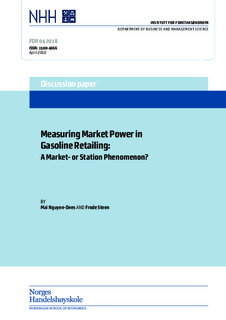Measuring Market Power in Gasoline Retailing: A Market- or Station Phenomenon?
| dc.contributor.author | Nguyen-Ones, Mai | |
| dc.contributor.author | Steen, Frode | |
| dc.date.accessioned | 2018-04-19T09:51:30Z | |
| dc.date.available | 2018-04-19T09:51:30Z | |
| dc.date.issued | 2018-04-19 | |
| dc.identifier.issn | 1500-4066 | |
| dc.identifier.uri | http://hdl.handle.net/11250/2494980 | |
| dc.description.abstract | Applying detailed consecutive daily micro data at the gasoline station level from Sweden we estimate a structural model to uncover the degree of competition in the gasoline retail market. We find that retailers do exercise market power, but despite the high upstream concentration, the market power is very limited on the downstream level. The degree of market power varies with both the distance to the nearest station and the local density of gasoline stations. A higher level of service tends to raise a seller’s market power; self-service stations have close to no market power. Contractual form and brand identity also seem to matter. We find a clear result: local station characteristics significantly affect the degree of market power. Our results indicate that local differences in station characteristics can more than offset the average market power found for the whole market. | nb_NO |
| dc.language.iso | eng | nb_NO |
| dc.publisher | FOR | nb_NO |
| dc.relation.ispartofseries | Discussion paper;4/18 | |
| dc.subject | Gasoline markets | nb_NO |
| dc.subject | market power | nb_NO |
| dc.subject | markup estimation | nb_NO |
| dc.subject | local market competition | nb_NO |
| dc.title | Measuring Market Power in Gasoline Retailing: A Market- or Station Phenomenon? | nb_NO |
| dc.type | Working paper | nb_NO |
| dc.source.pagenumber | 34 | nb_NO |
Tilhørende fil(er)
Denne innførselen finnes i følgende samling(er)
-
Discussion papers (FOR) [566]
